TwinBee (ツインビー) is a video game series composed primarily of cartoon-themed vertical-scrolling shoot-'em-up games produced by Konami that were released primarily in Japan. The series originated as a coin-operated video game simply titled TwinBee in 1985, which was followed by several home versions and sequels. The character designs of almost every game in the series since Detana!! TwinBee in 1991 were provided by Japanese animator Shuzilow HA, who also planned and supervised most of the subsequent installments in the TwinBee series. The series also inspired a radio drama adaptation that lasted three seasons in Japan, as well as an anime adaptation.

Salamander, retitled Life Force in North America and in the Japanese arcade re-release, is a scrolling shooter arcade video game developed and published by Konami. Released in 1986 as a spin-off of Gradius, Salamander introduced a simplified power-up system, two-player cooperative gameplay and both horizontally and vertically scrolling stages. Some of these later became normal for future Gradius games. In Japanese, the title is written using ateji, which are kanji used for spelling foreign words that has been supplanted in everyday use by katakana. Contra, another game by Konami was also given this treatment, with its title written in Japanese as 魂斗羅.
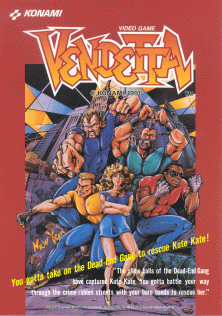
Vendetta, known in Japan as Crime Fighters 2 (クライムファイターズ2), is a 1991 side-scrolling beat-'em-up arcade game developed and published by Konami. It is the sequel to 1989 Konami's Crime Fighters, although it was marketed internationally as a stand-alone game with no previous connections.
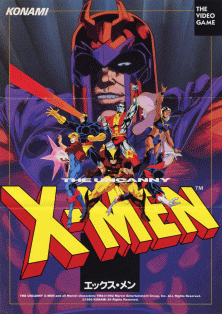
X-Men is a side-scrolling beat 'em up game produced and released by Konami for arcades in 1992, based on the Marvel Comics superhero team of the same name. The in-game character designs are based on the 1989 cartoon X-Men: Pryde of the X-Men. In the game, up to six players control the X-Men to defeat their archenemy Magneto. The six-player version of the game utilizes two screens housed in a deluxe cabinet. It was one of the top five highest-grossing dedicated arcade games of 1992 in the United States, while the Amusement & Music Operators Association (AMOA) nominated it for the "most innovative new technology" award.
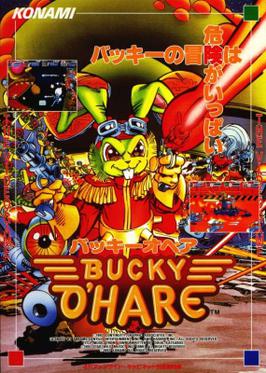
Bucky O'Hare is an arcade game produced by Konami in 1992.

The Simpsons is an arcade beat 'em up developed and published by Konami released in 1991. It was the first video game based on the Simpsons franchise to be released in North America. The game allows up to four players to control members of the Simpson family as they fight various enemies to rescue the kidnapped Maggie. It was a commercial success in the United States, where it was one of the top three best-selling arcade video game machines of 1991, The game also features the television shows's voice actors; Dan Castellaneta, Julie Kavner, Nancy Cartwright and Yeardley Smith reprising their respective roles as the Simpsons family.

Teenage Mutant Ninja Turtles: Turtles in Time, released as Teenage Mutant Hero Turtles: Turtles in Time in Europe, is a beat 'em up arcade video game produced by Konami and released in 1991. A sequel to the original Teenage Mutant Ninja Turtles arcade game, it is a scrolling beat 'em up type game based mainly on the 1987 TMNT animated series. Originally an arcade game, Turtles in Time was ported to the Super Nintendo Entertainment System in 1992 under the title Teenage Mutant Ninja Turtles IV: Turtles in Time, continuing the numbering from the earlier Turtles games released on the original NES. That same year, a game that borrowed many elements, Teenage Mutant Ninja Turtles: The Hyperstone Heist, was released for the Sega Genesis.

Rush'n Attack, also known as Green Beret in Japan and Europe, is a run-and-gun and hack-and-slash video game developed and released by Konami for arcades in 1985, and later converted to the Nintendo Entertainment System and home computers. Its North American title is a play on the phrase "Russian attack" due to its Cold War setting. It was ported to home systems and became a critical and commercial success for arcades and home computers.
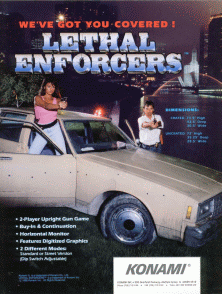
Lethal Enforcers is a 1992 light gun shooter released as an arcade video game by Konami. The graphics consist entirely of digitized photographs and digitized sprites. Home versions were released for the Super NES, Genesis and Sega CD during the following year and include a revolver-shaped light gun known as The Justifier.
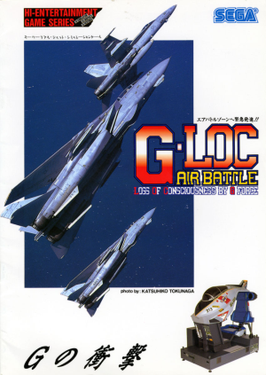
G-LOC: Air Battle is a 1990 combat flight simulator arcade video game developed and published by Sega. It is a spin-off of the company's After Burner series. The title refers to "G-force induced Loss Of Consciousness". The game is known for its use of the R360 motion simulator arcade cabinet. The arcade game was a commercial and critical success upon release.
Gradius is a series of shooter video games, introduced in 1985, developed and published by Konami for a variety of portable, console and arcade platforms. In many games in the series, the player controls a ship known as the Vic Viper.
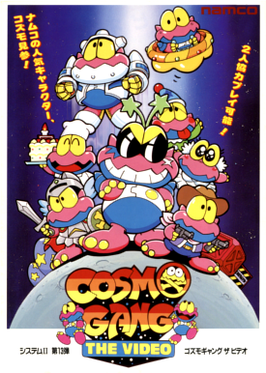
Cosmo Gang the Video is a 1992 fixed shooter arcade game developed and published by Namco. A home conversion for the Super Famicom was released the same year. Controlling the Hyper Beat starship, the player is tasked with ridding the galaxy of the Cosmo Gang, a race of aliens that cause mischief across Earth. Gameplay involves shooting enemies and avoiding projectiles. Power-up items can be collected to grant the player additional abilities. It ran on the Namco System 2 arcade board.

Sonic Blast Man is a video game franchise by Taito starring the titular superhero, Sonic Blastman. The game originally started as an arcade video game in 1990, but eventually made its way to the SNES in 1992, with much different gameplay. Both versions received a sequel.

Metamorphic Force is an arcade game released by Konami in August 1993. It is one of Konami's last side-scrolling beat 'em up games to appear in the arcades along Violent Storm.

TwinBee is a vertically scrolling shooter released by Konami as an arcade video game in 1985 in Japan. Along with Sega's Fantasy Zone, released a year later, TwinBee is credited as an early archetype of the "cute 'em up" type in its genre. It was the first game to run on Konami's Bubble System hardware. TwinBee was ported to the Family Computer and MSX in 1986 and has been included in numerous compilations released in later years. The original arcade game was released outside Japan for the first time in the Nintendo DS compilation Konami Classics Series: Arcade Hits. A mobile phone version was released for i-mode Japan phones in 2003 with edited graphics.

Shao-lin's Road (少林寺への道), also released in North America as Kicker, is a 1985 beat 'em up video game released by Konami. The game was commercially successful, becoming a chart hit in the arcades. It was ported to several early home computers and has also been featured in classics compilations Konami Arcade Classics for the PlayStation in 1998 and Konami Classics Series: Arcade Hits for the Nintendo DS in 2007.

Monster Maulers, known in Japan as Kyukyoku Sentai Dadandarn, is a 1993 fighting arcade game developed and published by Konami.
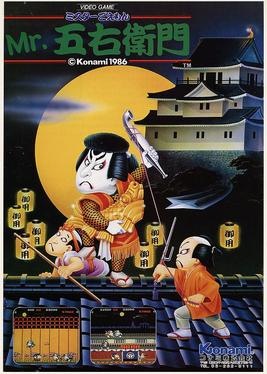
Mr. Goemon is a platform game developed by Konami and released in arcades in 1986. The side-scrolling game is based on Ishikawa Goemon, an outlaw in 16th-century Japan. It is the first game in the Ganbare Goemon series.

Guardians of the 'Hood is a 1992 side-scrolling beat 'em up developed and released by Atari Games for arcades. The game features digitized sprites, similar to Pit-Fighter, and sprite scaling effects that gives a feeling of depth. It was originally sold in both dedicated cabinets and conversion kits.

Teenage Mutant Ninja Turtles, released in Japan as TMNT: Super Kame Ninja and in Europe as Teenage Mutant Hero Turtles, is a 1989 beat 'em up arcade game released by Konami. It is based on the Teenage Mutant Ninja Turtles franchise, including the first animated series that began airing two years earlier. In the game, up to four players control the titular Ninja Turtles, fighting through various levels to defeat the turtles' enemies, including the Shredder, Krang and the Foot Clan. Released during a high point in popularity for the Teenage Mutant Ninja Turtles franchise, the arcade game was a worldwide hit, becoming the highest-grossing dedicated arcade game of 1990 in the United States and Konami's highest-grossing arcade game. Versions for various home systems soon followed, including the Nintendo Entertainment System. A sequel, Teenage Mutant Ninja Turtles: Turtles in Time, was released in 1991.

















